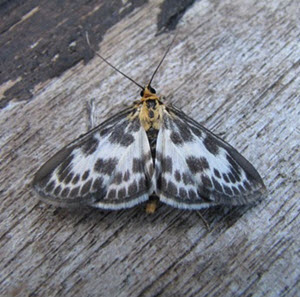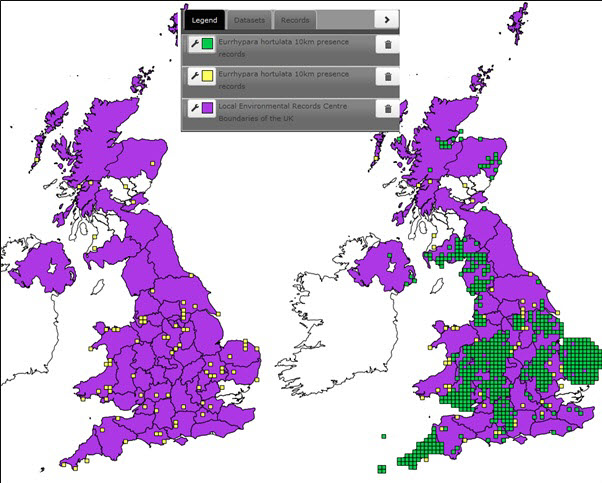Written by Teresa Frost, manager of Cumbria Biodiversity Data Centre
I started recording moths in my back garden two years ago. Anyone who, like me, gets themselves a light trap knows how exciting it is to open the box on a summer morning and discover the ever-changing beauty that lies within. Then comes the enjoyable but challenging task of sorting through and the steep learning curve of hundreds of moths to get familiar with, even when you discount the “LBJ”s. Thumbing through the rapidly well worn Waring Field Guide to the Moths of Great Britain and Ireland on the so-called Macro-moths, and its sister book on Micro-moths, eventually you have made a good stab at naming everything. The macro/micro division is somewhat arbitrary; species in the Macro-moth families are usually large whilst those in the Micro-moth families are often small enough to need magnification to help identify them, but there is some overlap in species’ sizes.
For me at least, knowing its name is not yet enough – I want to know a bit more about the new species that I’ve just been up close and personal with. Luckily for moths there are not only books but extensive excellent online resources available. What does it eat – elm, do we have that here? – oh yes, at the bottom of the garden, I’ve never noticed that before!
I also like to find out where it lives – is this a species I could see around the country or is it perhaps something that only lives in northern Britain? Text descriptions and maps in books are great, but it is very handy to be able to quickly look at a species map online wherever you are. One of the most used websites by moth recorders is ukmoths.org.uk which has a page for each species, including maps which run off the NBN Gateway’s webservices. The maps of the macro-moth families use only records from the National Moth Recording Scheme. However for micro-moths there is (currently) no national micro-moth recording scheme and so the UKMoths website maps use all the records on the NBN Gateway from multiple data providers.

The Small Magpie, Anania hortulata, is a bit of a challenge the first time you come across it; as one of those micros that are bigger than many macros, you have often gone through the Macro field guide several times before picking up the micro field guide, or asking your local moth group, iSpot or social media for help. It’s striking, widespread and common, in southern Britain at least. So once learnt, many recorders will send records of this species to their county moth recorder or county micro-moth recorder, or directly to their Local Environmental Records Centre (LERC). Although recorder coverage varies, I suspect there are few LERCs who do not hold at least some records of this cheerful species.
It is easy to find out how important LERC records are for distribution maps powered by the NBN Gateway, particularly so for common and widespread species like Small Magpie that aren’t covered by any national scheme. In the Interactive Map on the Gateway you can select which datasets are mapped to see where the “dots” are coming from. As a test, I added the Small Magpie layer twice. For the first layer, coloured yellow, I ticked on all the non-LERC datasets, most of which were from Wildlife Trusts, country agency’s datasets or the National Trust. For the second layer, coloured green, I ticked on all the LERC datasets. With the LERC boundaries underlaid, it is easy to see the difference it makes to the national mapped distribution of this species when an LERC adds a micro-moth dataset to their publicly viewable datasets on the NBN Gateway.

I am fortunate to live on the Dumfriesshire side of the Dumfries and Galloway/Cumbria border where both Cumbria Biodiversity Data Centre (the LERC I myself manage) and Dumfries and Galloway Environmental Resources Centre share all available micro-moth records for their respective counties with the NBN Gateway, so I can immediately see the local distributions for this species. Even better, DGERC has worked with the local moth recorders to create a fantastic local website for me to satisfy my thirst for knowledge on local macro and micro moth populations – www.dgmoths.org.uk. It includes maps which – you guessed it – run off the NBN Gateway.
I know there are also many excellent local moth group websites, often supported by LERCs, which include maps that don’t run off the Gateway and are a fantastic resource for getting that detailed local perspective. But isn’t it worthwhile enabling the big picture too? My challenge to all my fellow LERCs is to take the view that our role in supporting recorders and recording should go beyond individual operating area boundaries. In the NBN we each have a part to play in helping the public discover more about biodiversity, and it is only by doing this that new recorders will continue to be engaged and old hands carry on submitting records. The NBN Gateway is only one of the ways which we do this as a Network, but it is an important one.
I picked on micro-moths as an example of a group increasing in popularity in terms of recording. But there are many others, even species which are covered by a national scheme, where some of the white space on the NBN Gateway national map is not because the species isn’t there, or that recorders haven’t recorded it, but because records for which LERCs are the custodian haven’t been shared.
There are often valid reasons and locally specific challenges to sharing data on the NBN Gateway and this article is not in the least intended to berate LERCs who don’t currently share particular datasets. I merely hope to remind all LERCs, and the county recorders they work with, that all the negotiation, compromise and technical effort that goes in to sharing data – even high level, 10km presence data – is appreciated by recorders like me and the local recorders I work with in Cumbria. It benefits naturalists all over the country, even those using a third party website who perhaps don’t even realise what the NBN is, or understand where the records and technology are coming from to create the map they are looking at. And that’s the beauty of the NBN!
